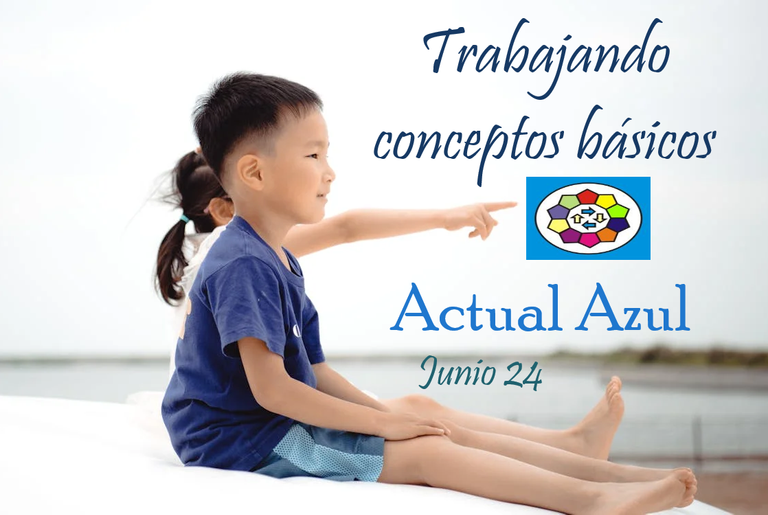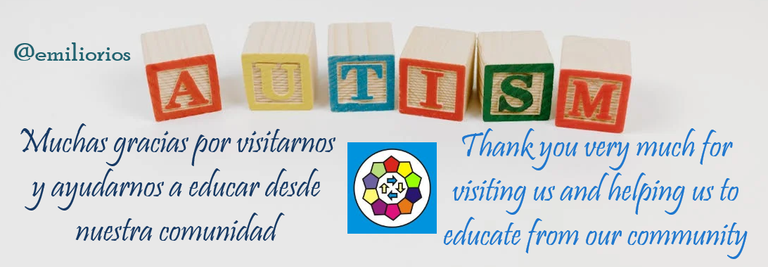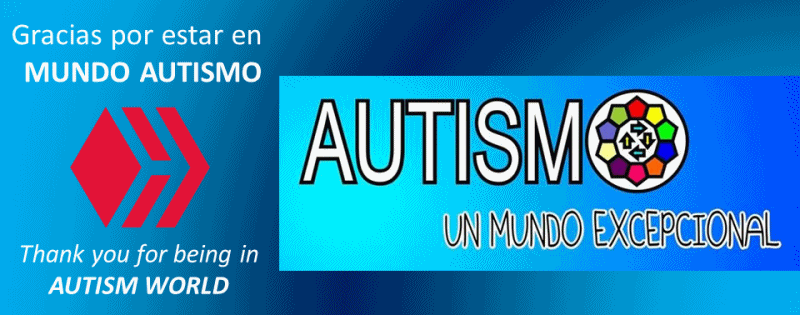

Es cierto que, prácticamente, todas las personas saben ya lo que es Autismo o los Trastornos del Espectro Autista, porque gracias a las investigaciones y a que se ha podido definir, la gente lo ha tenido en la atención de forma más frecuente.
Sin embargo, se nos siguen olvidando cosas básicas, conceptos básicos sobre esta condición, que es necesario recordar para entender mejor.
Hoy, en Martes de Actual Azul, vamos a repasar conceptualizaciones básicas, para recordar lo que sabemos, para no callarlo y, por supuesto, para que no las olvidemos.
La acción educativa debe ser algo que hagamos diariamente y en cada lugar a donde vayamos.


Dos áreas muy complicadas
Recordemos que esta condición tiene que ver con el desarrollo neurológico, por lo que va a generar conductas que afectan socialmente a la comunicación del individuo y sus emociones.
No queremos decir que no exista interacción o comunicación, sino que es diferente.
Pero no depende del ser humano; esto proviene de factores genéticos y algunos del entorno -que es lo que se ha descubierto hasta los momentos- que hacen que el desarrollo de los patrones a nivel cerebral, sean diferentes.
Los podemos ver a partir de los dos años de edad y son un reto para los profesionales de la salud y para la misma familia, explicar y definir.
Es un desarrollo atípico de las habilidades neurológicas de comunicación e interacción social, no hay reciprocidad emocional y hay condutas de patrones repetitivos que restringen los intereses del individuo.

Los derechos humanos en TEA
Hasta ahora sabemos que se están defendiendo a muchos niveles los derechos humanos que tienen las personas que sufren de este trastorno, porque son objeto de discriminación y, por supuesto, mucha estigmatización.
De hecho, hay mucho bullying a nivel de las instituciones educativas, y toda esta diferencia genera una injusta atención a nivel educacional.
También, a nivel de la salud, la atención es deficiente y confusa; y yo pienso que por desconocimiento.
Y a nivel comunitario no podemos decir que la cosa esté más fácil, pues hay muchas restricciones de oportunidades a nivel de las comunidades en las que viven.
Por otro lado, existen afecciones que van a la par con este trastorno que deben ser prevenidas, ya que pueden ser personas vulnerables a padecer enfermedades no transmisibles crónicas debido a su inactividad, a sus preferencias en la alimentación y porque, debemos decirlo, sufren mayor propensión a la violencia, al abuso y a las lesiones.
Esto lo decimos diariamente y luchamos por los derechos de estos niños; más, nunca es poco lo que podamos hacer y decir, porque seguimos observando discriminación y violencia hacia ellos.

Los síntomas, recordemos algunos síntomas...
Ante todo, tengamos conciencia de que existen personas con TEA con alto funcionamiento, pero que siempre guardan algunos síntomas; y los que ya tienen funcionamiento alterado, que son clásicos y se observa a simple vista que lo son.
Así que, es importante abordarlo basándonos en criterios diagnósticos, y a mí me gustan los del DSM 5 o el Manual Diagnóstico de los Trastornos Mentales.
Allí se expone que hay dificultad para la comunicación social, patrones repetitivos pero restringidos, que hay estereotipias, palabras repetidas, golpeteos con objetos y ritualismo.
Síntomas y signos que aparecen a edades tempranas del desarrollo, -ya hemos hablado desde los pocos años de vida, dos años, en casos graves-; y que estos síntomas causan interferencia en la cotidianidad a todos los niveles, desde el hogar hasta la escuela y, más grave aún, a nivel emocional.

Y seguimos insistiendo en cómo tratarlos
Como médico, me gusta dar tres sugerencias básicas; y lo primero es entenderlos, para así poder respetar su propio espacio.
La hipersensibilidad hace que ellos se aíslen para protegerse del exceso de estímulos, por lo que el espacio es importante, ya que la interacción social genera actividades emocionales sumamente intensas.
Segundo, entender que son rutinarios y que cambiar les genera incomodidad, inseguridad y miedo.
Y, por último, aprender a aceptar sus estereotipias, porque son individuales y le ayudan a gestionar emociones y hay maneras de actuar a nivel visual, táctico, gustativo, olfativo.
Desde chasquear dedos hasta mover los brazos y balancearse, son conductas que hacen que ellos puedan gestionar sus emociones, por lo que van a ayudarle a tolerar sensaciones y a mantenerse concentrados.
Comprender esto nos permite respetárselos y aceptar sus beneficios.

Explicarle a otros sigue siendo lo más difícil
Como vemos, hay muchos temas que por sabidos, se ignoran y se callan, y al tenerlos callados terminamos olvidándolos.
A veces, comprender lo básico y actuar desde el significado de algo, supone que podamos seguir alimentando investigaciones y conociendo aún más sobre el tema.
Lo más difícil, a mi parecer, es poder explicarle a la gente, sobre todo a aquellos que no tienen en sus núcleos familiares, a personas con trastornos del espectro autista, lo que es el autismo.
¿Cómo hacer para entenderlos y cómo deben ser nuestras interacciones con ellos?
Y más importante aún, primario, a mi modo de ver, es comprenderlos a ellos desde la perspectiva más empática posible; y aunque esto es difícil, tratar de ponernos en su lugar.
Si conocemos sobre la hipersensibilidad, la indefensión y la dificultad para expresar lo que se siente, podemos entender que no es una enfermedad o algo que se cura, sino que se adapta.


Things we know, we keep quiet and forget -A brief review of the basics of Autism- In Tuesday's Actual Blue


It is true that practically everyone knows what Autism or Autism Spectrum Disorders is, because thanks to research and the fact that it has been defined, people have had it in their attention more frequently.
However, we keep forgetting basic things, basic concepts about this condition, which is necessary to remember in order to understand it better.
Today, in Actual Blue Tuesday, we are going to review basic conceptualizations, to remember what we know, so as not to keep quiet about it and, of course, so that we do not forget them.
Educational action must be something we do daily and in every place we go.


Two very complicated areas
Let us remember that this condition has to do with neurological development, so it will generate behaviors that socially affect the individual's communication and emotions.
We do not mean that there is no interaction or communication, but it is different.
But it does not depend on the human being; this comes from genetic factors and some environmental factors -which is what has been discovered so far- that make the development of patterns at the brain level different.
We can see them from two years of age and they are a challenge for health professionals and for the family itself to explain and define.
It is an atypical development of neurological skills of communication and social interaction, there is no emotional reciprocity and there are repetitive patterns that restrict the interests of the individual.

Human rights in ASD
So far we know that the human rights of people with this disorder are being defended at many levels, because they are subject to discrimination and, of course, a lot of stigmatization.
In fact, there is a lot of bullying at the level of educational institutions, and all this difference generates an unfair attention at the educational level.
Also, at the health level, the attention is deficient and confusing; and I think that this is due to lack of knowledge.
And at the community level, we cannot say that things are easier, because there are many restrictions of opportunities at the level of the communities in which they live.
On the other hand, there are conditions that go hand in hand with this disorder that should be prevented, because they may be vulnerable to chronic non-communicable diseases due to their inactivity, their food preferences and because, we must say it, they are more prone to violence, abuse and injury.
We say this on a daily basis and fight for the rights of these children; more, there is never little we can do and say, because we continue to observe discrimination and violence towards them.

Symptoms, let's remember some symptoms...
First of all, let's be aware that there are people with ASD with high functioning, but who always keep some symptoms; and those who already have altered functioning, who are classic and you can see at a glance that they are.
So, it is important to approach it based on diagnostic criteria, and I like those of the DSM 5 or the Diagnostic Manual of Mental Disorders.
There it states that there is difficulty with social communication, repetitive but restricted patterns, that there are stereotypies, repeated words, tapping with objects and ritualism.
Symptoms and signs that appear at early ages of development, -we have already spoken from a few years of life, two years, in severe cases-; and that these symptoms cause interference in daily life at all levels, from home to school and, even more serious, at an emotional level.

And we keep insisting on how to treat them
As a physician, I like to give three basic suggestions; and the first is to understand them, so that we can respect their own space.
Hypersensitivity causes them to isolate themselves to protect themselves from excessive stimuli, so space is important, since social interaction generates extremely intense emotional activities.
Second, understand that they are routine and that changing generates discomfort, insecurity and fear.
And finally, learn to accept their stereotypies, because they are individual and help them manage emotions and there are ways to act visually, tactilely, gustatory, olfactory.
From snapping fingers to moving their arms and swinging, these are behaviors that help them manage their emotions, so they will help them tolerate sensations and stay focused.
Understanding this allows us to respect them and accept their benefits.

Explaining to others continues to be the most difficult thing to do
As we can see, there are many topics that are ignored and kept quiet, and by keeping them quiet we end up forgetting them.
Sometimes, understanding the basics and acting from the meaning of something, means that we can continue to feed research and learn even more about the subject.
The most difficult thing, in my opinion, is to be able to explain to people, especially to those who do not have people with autism spectrum disorders in their families, what autism is.
How can we understand them and how should our interactions with them be?
And even more important, primary, in my opinion, is to understand them from the most empathic perspective possible; and although this is difficult, try to put ourselves in their place.
If we know about hypersensitivity, helplessness and the difficulty to express what one feels, we can understand that it is not a disease or something that is cured, but something that adapts.

Emilio Ríos – Venezuela
@emiliorios


- Barras separadoras y logo de English, creadas y editadas en Paint.
Separator bars and English logo, created and edited in Paint.
Cintillo personalizado de @emiliorios con el logo de #Hive, realizado por la excelente creadora @mosa71
Custom @emiliorios banner with the #Hive logo, made by the excellent content creator @mosa71Logo de Twitter tomado de la plataforma de la red social.
Twitter logo taken from the social network platform.Imagen de agradecimiento, tomando el logo de nuestra comunidad y editada en Paint, de:
Thank you image, taking our community logo and edited in Paint, by:
Pexels-Tara Winstead
- Si lo deseas, puedes seguirnos en:
If you wish, you can follow us at:






